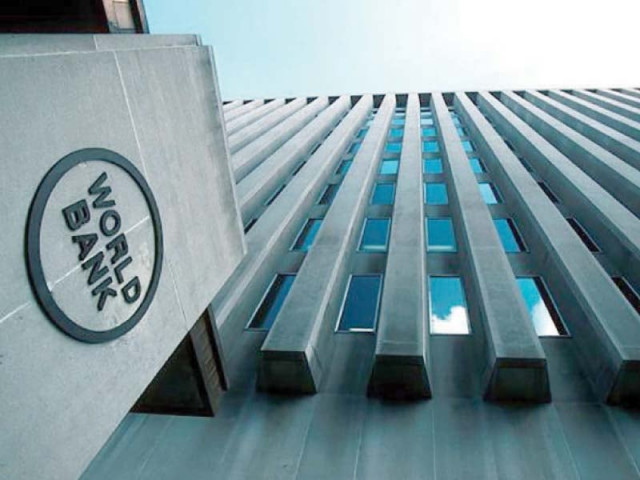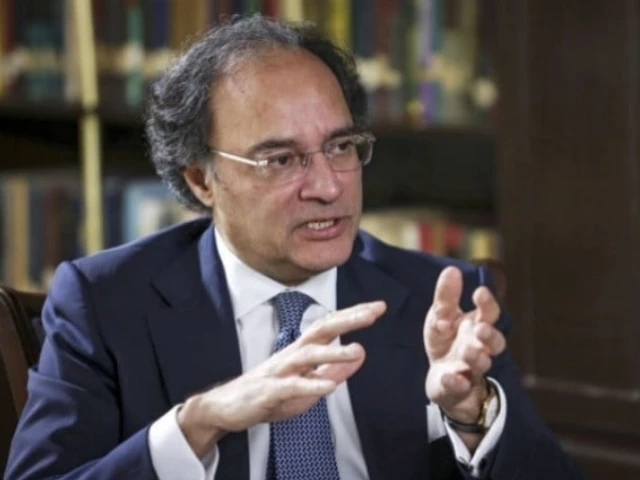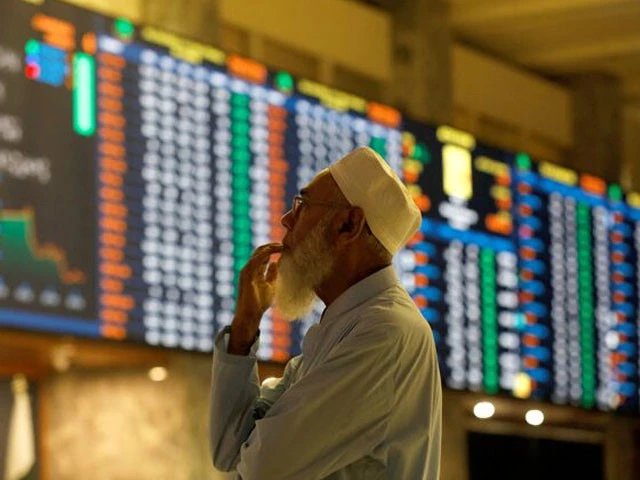Business
Poverty down, but no lift in living standards: WB | The Express Tribune

Lender bases assessment on simulation data; Floods in Punjab deepen rural household losses
World Bank. PHOTO: FILE
ISLAMABAD:
The World Bank claimed on Tuesday that Pakistan’s poverty rate decreased to 22.2% and it would sink further to pre-Covid levels this year, yet reiterating that the country’s current economic growth rate was not enough to reduce poverty and improve the living standard.
The paradoxical statements by the lender underscore the emergent need for the latest credible data, as the World Bank too has assumed the poverty reduction by running a simulation exercise on 2019 consumption data of Pakistan.
The Washington-based lender released its flagship annual ‘Pakistan Development Update’ report, which showed a declining trend in poverty, marking a departure from it’s a month-old statement that the current economic model cannot reduce poverty.
The World Bank on Tuesday also upward adjusted Pakistan’s economic growth forecast to 3% for this fiscal year, which is slightly better than its few days old forecast of 2.7%.
While projecting the poverty rate already declined to 22.2% and to reduce further to 21.5% in this fiscal year, the World Bank economist, Mukhtarul Hasan, also said that the current economic growth rate was “not enough” to improve the living standard and reduce poverty.
Responding to a question by The Express Tribune, Christina Wieser, the bank’s lead poverty expert, refuted that there was any pressure by the government to change the last month’s forecast of poverty going northbound.
Last month, the World Bank had said that “Pakistan’s growth model that supported initial poverty reduction has proven insufficient to sustain progress and poverty is on the rise since 2021-22”.
Wieser clarified that in the absence of the latest consumption data, the World Bank has used some strong assumptions in simulation models, which showed poverty declining. She disclosed that the World Bank had assumed that the increase in sectoral growth is also fully passed on to labour wages.
But this assumption that may not be true as even some government departments are not paying the minimum Rs37,000 per month wage to its daily wage employees and it did not increase the wages in this budget.
Wieser further said that the World Bank will make further adjustments in its poverty estimates once the latest ‘Household Integrated Economic Survey’ data is available in next couple of months.
While presenting the findings here at the World Bank’s local office, Wieser said that higher growth and lower inflation contributed to a decrease in poverty, with the poverty rate, measured at the national poverty line, estimated to have fallen to 22.2% in the last fiscal year from 25.3% of June 2024.
Strong growth in the construction and logistics sectors, which employ around one-quarter of all working poor, boosted labour incomes, said Wieser. However, last month the World Bank said that due to lower wages in the construction sector, the poverty was on the rise in Pakistan.
She said that a sharp drop in food inflation reduced price pressures and improved the purchasing power of the poor, who spend roughly 45% of their household budgets on food. But the report underlined that the floods are anticipated to affect poor and vulnerable rural households, who face the loss of agricultural assets, with limited savings and inadequate coping mechanisms.
These vulnerabilities are compounded by rising food inflation and the volatility of informal jobs in low skill industry and services sectors, according to the report. “As a result, the pace of poverty reduction is expected to slow, with poverty declining only modestly to 21.5% in fiscal year 2026 and to 20.6% in fiscal year 2027.
The report also explicitly stated that since 2019, Pakistan has undergone several major crises, including the Covid-19 pandemic, devastating floods in 2022, and a macroeconomic crisis made more precarious by increased political uncertainty.
It is expected that these shocks had a profound impact on household welfare and poverty rates in the country, but recent survey data is not available to quantify these. In this context, welfare levels for Pakistan can be estimated using a micro-simulation tool which models the path of household welfare based on macroeconomic indicators.
The report added that the underlying assumption for this approach is that macroeconomic indicators, such as sectoral GDP growth, inflation, and changes in the real value of private and public transfers, directly influence households’ real labour and non-labour incomes, which in turn has a direct bearing on consumption levels and poverty.
Bolormaa Amgaabazar, the World Bank’s country head, said that recent floods, have complicated the outlook, imposing significant human costs and economic losses, thereby dampening growth prospects, and posing additional challenges to macroeconomic stability amid constrained fiscal space, high external financing needs, and major regional and global uncertainties.
Budget is vulnerable
The report reflected that meeting the budget targets of economic growth, provincial cash surpluses and budget deficit would not be possible. The budget continues to be predicated on optimistic growth targets and revenues, according to the report. It added that the budget estimates real GDP growth of 4.2% is significantly above World Bank and IMF forecasts.
Increases in provincial surpluses carry risks due to floods, said the lender, adding that the federal budget projects a 45.1% increase in provincial surpluses, a key component of Pakistan’s fiscal consolidation strategy.
This increase hinges on the successful implementation of provincial Agriculture Income Tax (AIT) regimes, effective since January 1, 2025, with tax liabilities for the second half of FY25 expected to be collected in the first quarter of FY26.
Provinces are also expected to strengthen GST collection of services. However, these targets carry significant risks. Provinces will need to curb expenditure growth to maintain surpluses, a task that may prove difficult if revenue performance falls short, said the lender.
The recent floods, particularly in Punjab, threaten agricultural output. Mukhtarul Hasan said that based on the assumption that the flood impacts are limited, fiscal discipline is maintained, and the IMFEFF programme stays on track, economic growth is expected to remain at 3%. A few days ago, the World Bank had cut the economic growth projection to 2.6%.
Inflation & external sector
The flood-related shock to food supply is expected to push inflation above earlier projections, peaking at 7.2% in the current fiscal year, which is slightly higher than the official target.
The current account is projected to return to a small deficit of 0.3% of GDP in this fiscal year as remittances and lower oil prices offset export losses and higher food imports, according to the lender. It said that as post-flood recovery boosts import demand and remittances normalise, the deficit is expected to widen further in the next fiscal year.
The World Bank has sought more visibility in the movement of exchange rate market. It has recommended enabling a deep and liquid interbank market without SBP intermediation and broader participation from market players, including exporters, importers, and foreign investors.
The lender has demanded publishing detailed data on interbank market transactions, including volumes and participants and phasing out ad hoc interventions so that the exchange rate reflects actual supply and demand.
Anna Twum, the bank’s expert on international trade, said that Pakistan’s exports were hardly equal to 0.1% of the global exports, which in the case of India was over 5%. She cautioned that 70% of Pakistan’s exports were at risk due to new standards being introduced by the European Union (EU).
Budget deficit
The lender said that fiscal consolidation is expected to continue under the ongoing IMF programme. However, flood-related relief and reconstruction needs will add to spending pressures, with the fiscal deficit projected to remain elevated at 5.4% of GDP in FY26, which is above the official target.
The World Bank said that public debt is expected to remain elevated to 76% of the GDP due to modest flood related spending and elevated financing needs. The gross financing needs will nevertheless remain high, reflecting maturing short-term debt, repayments to multilateral and bilateral creditors, and upcoming Eurobond maturities, according to the lender.
Business
CII Lays Out Investment Roadmap For Budget 2026-27

India’s next phase of economic growth will depend on steady and strong investment across public, private, and foreign channels, according to the Confederation of Indian Industry (CII). CII, in a release, laid out a detailed plan for the Union Budget 2026-27, saying that the Budget needs to act as both a stabiliser and a growth driver.
CII Director General Chandrajit Banerjee said the coming Budget must focus on boosting investments to keep India’s growth steady. He explained that public spending has pushed the country’s recovery after the pandemic, and that continued support in this area will help India stay on track as one of the fastest-growing major economies.
CII has suggested raising central capital expenditure by 12 per cent and increasing support to states by 10 per cent in FY27. These funds, it said, should go mainly to areas where spending creates the highest impact, such as transport, energy, logistics, and the green transition. CII also recommended creating a Capital Expenditure Efficiency Framework to help select and track important projects and measure their outcomes more clearly. Along with this, it proposed launching a new Rs 150 lakh crore National Infrastructure Pipeline for 2026-32 to give long-term clarity to investors and states.
The release also noted that India needs a more flexible fiscal policy. CII suggested shifting from strict annual deficit rules to a debt framework that adjusts with economic cycles. This, it said, would help the government respond better during shocks without losing long-term stability.
On private investment, CII highlighted that India now needs strong momentum from businesses to support growth. “The Government of India has provided a big demand push via income tax relief in last year’s Union Budget and recently via GST 2.0. Investments, especially private sector investment, will be the next big driver for economic growth that needs to be focused on in the next fiscal to continue the growth momentum,” Banerjee said.
CII recommended tax credits or easier compliance for companies that increase investments or production, along with returning accelerated depreciation to help firms, especially MSMEs, modernise.
To attract long-term global capital, CII proposed creating an NRI Investment Promotion Fund with partial government holding. This fund would help channel NRI and foreign institutional money into areas like infrastructure and AI. It also suggested strengthening the National Investment and Infrastructure Fund through a new Sovereign Investment Strategy Council to guide investments.
CII further called for simpler external borrowing rules and a single-window system for large foreign investment proposals to reduce delays and increase certainty. It also suggested forming an India Global Economic Forum to allow structured discussions between global investors and government leaders.
“An investment-driven growth strategy, anchored in fiscal credibility and institutional reforms, will define India’s next development phase,” Banerjee said.
Business
Can Indians Switch To A 4-Day Work Week? Here’s What Govt Says

New Delhi: For decades, the five-day work week has been the norm for most Indian employees. However, with rising conversations around work–life balance and productivity, many are now wondering if a four-day work week could become a reality in India. Several countries such as Japan, Germany and Spain have already experimented with shorter work schedules and reported encouraging outcomes. Interestingly, recent changes and discussions around India’s labour laws indicate that a four-day work week may be possible for certain sections of the workforce.
What the Labour Ministry Has Said on 4-Day Work Week
The Ministry of Labour and Employment recently clarified on X (formerly Twitter) that a four-day work week is possible under the new Labour Codes. According to the Ministry, employees can work for 12 hours a day for four days, while the remaining three days will be paid holidays. However, the total weekly working hours will still be capped at 48 hours, and any work beyond 12 hours in a day will have to be paid at double the normal wage rate.
Flexible Work Schedule Allowed Under New Labour Codes
The Labour Ministry has said that the revised Labour Codes allow employees to work 12 hours a day for four days, while the remaining three days can be taken as paid holidays, making a four-day work week possible under the new rules.
Weekly Work Hours Cap Remains Unchanged
The Labour Ministry clarified that the total working hours in a week will still be capped at 48 hours, even under a four-day work schedule. It also noted that the 12-hour workday includes breaks and spread-out time, ensuring employees are not working continuously for the entire duration.
What’s New Under India’s Updated Labour Laws
On November 21, 2025, the government consolidated 29 existing labour laws into four new labour codes—the Code on Wages (2019), Industrial Relations Code (2020), Social Security Code (2020), and the Occupational Safety, Health and Working Conditions Code (2020). The move aims to simplify labour regulations while ensuring timely payment of wages, regulated working hours, better workplace safety and wider access to health and social security benefits.
A major change under the new codes is for fixed-term employees. They are now entitled to the same benefits as permanent workers, including leave, health coverage and social security. Notably, fixed-term workers can claim gratuity after just one year of continuous service, instead of the earlier five-year requirement, and must be paid wages equal to permanent employees doing similar work.
Business
Investment focus: CII pitches reforms for Budget 2026-27; industry body seeks capex push – The Times of India

The Confederation of Indian Industry (CII) has urged the Centre to adopt a wide-ranging set of reforms in the Union Budget 2026-27 to reinforce India’s investment-led growth cycle and sustain its position as one of the world’s fastest-expanding major economies, PTI reported.In a detailed submission for the upcoming Budget, CII recommended raising central capital expenditure by 12% and increasing capex support to states by 10% in FY27, launching a Rs 150 lakh crore National Infrastructure Pipeline (NIP) 2.0 for 2026-32, and introducing incremental tax credits or compliance relaxations for companies achieving notable milestones in investment, output or tax contribution. The industry body also sought an NRI Investment Promotion Fund and the reinstatement of accelerated depreciation benefits to spur fresh capital expenditure, especially for MSMEs and manufacturing sectors, without triggering Minimum Alternate Tax (MAT) liability.CII said strengthening the National Investment and Infrastructure Fund (NIIF) through a proposed Sovereign Investment Strategy Council (SIFC) would help align investments with national economic priorities. The Union Budget for FY27 is scheduled to be presented on February 1.According to the industry chamber, replacing rigid annual fiscal-deficit rules with an economic-cycle-based public debt framework would bolster resilience and allow counter-cyclical flexibility during global shocks, while ensuring the credibility of medium-term debt sustainability.“The forthcoming Union Budget 2026-27 has to serve the dual role of stabiliser and growth enabler, and promoting investments will be one of the most critical components in this regard,” said CII Director General Chandrajit Banerjee.He added that CII’s proposals centre on fiscal prudence, capital efficiency and building investor confidence.CII stressed that public capex has been the backbone of India’s post-pandemic recovery, crowding in private investment. To improve execution, it suggested creating a Capital Expenditure Efficiency Framework (CEEF) for selecting high-impact projects and monitoring outcomes based on productivity and regional growth spillovers.The chamber said facilitating private and foreign investment will be essential in driving the next phase of expansion. It proposed tax incentives linked to new investment and production milestones in high-growth areas such as clean energy, electronics, semiconductors and logistics. It also suggested the creation of an NRI Investment Promotion Fund — a government-private entity with up to 49% government stake — to mobilise overseas and institutional capital into infrastructure and emerging sectors.Further, easing external commercial borrowing norms with higher limits, longer tenures and partial risk cover for infrastructure and manufacturing projects would improve access to foreign capital, CII said. A single-window clearance system with deemed approval within 60-90 days for large FDI proposals was also recommended to accelerate big-ticket investment decisions.To deepen engagement with global investors, CII proposed an India Global Economic Forum — a government-led platform bringing together sovereign wealth funds, pension funds, private equity firms and multinational corporations for structured dialogue with senior policymakers.“An investment-driven growth strategy, anchored in fiscal credibility and institutional reforms, will define India’s next development phase,” Banerjee said.
-

 Politics7 days ago
Politics7 days agoThailand launches air strikes against Cambodian military: army
-

 Fashion7 days ago
Fashion7 days agoGermany’s LuxExperience appoints Francis Belin as new CEO of Mytheresa
-

 Politics7 days ago
Politics7 days agoZelenskiy says Ukraine’s peace talks with US constructive but not easy
-

 Tech1 week ago
Tech1 week agoWIRED Roundup: DOGE Isn’t Dead, Facebook Dating Is Real, and Amazon’s AI Ambitions
-

 Politics1 week ago
Politics1 week ago17 found dead in migrant vessel off Crete: coastguard
-

 Business4 days ago
Business4 days agoRivian turns to AI, autonomy to woo investors as EV sales stall
-

 Politics4 days ago
Politics4 days agoTrump launches gold card programme for expedited visas with a $1m price tag
-

 Tech5 days ago
Tech5 days agoJennifer Lewis ScD ’91: “Can we make tissues that are made from you, for you?”













